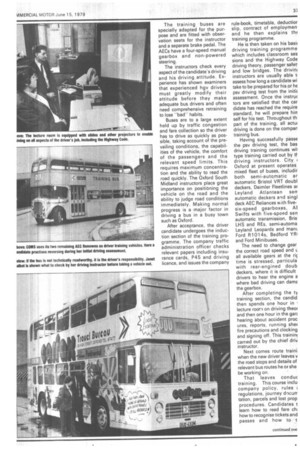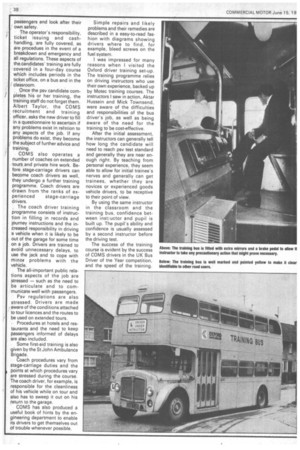Oxford training
Page 38

Page 39

Page 40

If you've noticed an error in this article please click here to report it so we can fix it.
for high tension
The bus driver's lot is a difficult one in these days of one-man operation and traffic jams. Noel IV illier reports from the City of Oxford's Motor's training school. Pic& Dick Ross
TO MANY Class one hgv drivers, the bus driver's job must seem a piece of cake. But in these days of one-person operation and extreme traffic congestion, the responsibility and stress of driving a stagecarriage bus in a city environment, hour after hour, are probably greater than those of most Other drivers.
With buses becoming more sophisticated, fares increasing and passengers less disciplined, the onus on the bus driver to keep to time, not break the bus and ensure efficient passenger control is great, and is still increasing. Drivers hours' regulations and psv requirements also are complicated, and likely to be increasingly enforced.
Bus and coach operators and the Road Transport Industry Training Board have designed bus and coach driver training programmes to ensure high standards in line with the responsibility of the job. For the past couple of year's, the RTITBsponsored UK Bus Driver of the Year competition has been won by a driver from National Bus Company subsidiary City of Oxford Motor Services.
With this in mind, I recently visited COMS driver training school, where I found basic training programmes which are thorough, quick and costeffective. Oxford's bus fleet is now 100 per cent one-personoperated and the route network includes busy city routes, interurban and rural services. The operator also runs coaches on private hire, extended tours and a certain amount of Continental work.
The COMS driving school trains from scratch car drivers, provisional licence holders, and drivers already holding psv and hgv licences. All potential drivers have to undergo training before being accepted into the Oxford strength. The length of their training varies according to an assessment of their driving performance by the company's driving instructors.
The candidate for the position of bus driver at COMS first undertakes a basic arithmetic test to ensure that he or she has the potential to handle cash — a skill clearly required to drive one-person-operated buses. Once their driving licence is checked, an initial driving appraisal is carried out.
The candidate takes out one of the company's two yellowpainted AEC Renown training buses. The candidate, under the eagle eye of one of the driving instructors, takes the bus on a comprehensive and complicated route. This route varies according to the driver's previous experience. Someone who already has a psv or hgv licence can expect a more complicated drive than a provisional or car licence-holder.
The instructor appraises the candidate's driving by using an RTITB tick-sheet from which the amount of tuition necessary to get the driver to the required standard for stage carriage work and testis assessed. The training buses are specially adapted for the purpose and are fitted with observation seats for the instructor and a separate brake pedal. The AECs have a four-speed manual gearbox and non-powered steering.
The instructors check every aspect of the candidate's driving and his driving attitude. Experience has shown examiners that experienced hgv drivers must greatly modify their attitude before they make adequate bus drivers and often need comprehensive retraining to lose "bad" habits.
Buses are to a large extent held up by traffic congestion and fare collection so the driver has to drive as quickly as possible, taking account of the prevailing conditions, the capabilities of the vehicle, the comfort of the passengers and the relevant speed limits. This requires maximum concentration and the ability to read the road quickly. The Oxford South Midland instructors place great importance on positioning the vehicle on the road and the ability to judge road conditions immediately. Making normal progress is a• major factor in driving a bus in a busy town such as Oxford.
After acceptance, the driver candidate undergoes the induction section of the training programme. The company traffic administration officer checks relevant papers including insurance cards, P45 and driving licence, and issues the company rule-book, timetable, deductior slip, contract of employmen and he then explains thi training programme.
He is then taken on his basil driving training programme which includes classroom ses sions and the Highway Code driving theory, passenger safet and low bridges. The drivini instructors are usually able t, assess how long a candidate wi take to be prepared for his or he psv driving test from the initi assessment. Once the instrut tors are satisfied that the car didate has reached the require standard, he will prepare hirr self for his test. Throughout th part of the training, all actui driving is done on the compar training bus.
Having successfully passe the psv driving test, the bas driving training continues wit type training carried out by ft driving instructors. City Oxford at present operates mixed fleet of buses, includir both semi-automatic ar automatic Bristol VAT doubl deckers, Daimler Fleetlines at Leyland Atlantean serr automatic deckers and singl deck AEC Reliances sAith fivesix-speed gearboxes, Al Swifts with five-speed see automatic transmission, Bris LHS and REs, semi-automa Leyland Leopards and main Ford R101 4s, Bedford YR, and Ford Minibuses.
The need to change gear the correct road speed and t, all available gears at the ric. time is stressed, particula with rear-engined doub deckers, where it is difficult drivers to hear the engine a where bad driving can dame the gearbox.
After completing the ty training section, the candid then spends one hour in . lecture root-t on driving therm and then one hour in the gar; hearing about accident proc ures, reports, running she fire precautions and clocking and signing off. This trainini carried out by the chief driy instructor.
Next comes route traini when the new driver leaves v the road stops and details of relevant bus routes he or she be working on.
That leaves conduc training. This course inclu company policy, rules regulations, journey d9curr tation, parcels and lost prop procedures. Candidates t learn how to read fare chi how to recognise tickets and passes and how to t passengers and look after their own safety.
The operator's responsibility, ticket issuing and cashhandling, are fully covered, as are procedues in the event of a breakdown and emergency and all regulations. These aspects of the candidates' training are fully covered in a four-day course which includes periods in the ticket office, on a bus and in the classroom.
Once the psv candidate completes his or her training, the training staff do not forget them. Albert Taylor, the COMS recruitment and training officer, asks the new driver to fill in a questionnaire to ascertain if any problems exist in rel9tion to any aspects of the job. If any problems do exist, they become the subject of further advice and training.
COMS also operates a number of coaches on extended tours and private hire work. Before stage-carriage drivers can become coach drivers as well, they undergo a further training programme. Coach drivers are drawn from The ranks of ex perienced stage-carriage drivers.
The coach driver training programme consists of instruction in filling in records and journey instructions and the increased responsibility in driving a vehicle when it is likely to be out of the garage for some time on a job. Drivers are trained to avoid unnecessary delays, to use the jack and to cope with minor problems with the vehicle.
The all-important public relations aspects of the job are stressed — such as the need to be articulate and to communicate well with passengers.
Psv regulations are also stressed. Drivers are made aware of the conditions attached to tour licences and the routes to be used on extended tours.
Procedures at hotels and restaurants and the need to keep passengers informed of delays are also included.
Some first-aid training is also .given by the St John Ambulance Brigade.
Coach procedures vary from Stage-carriage duties and the points at which procedures vary are stressed during the course. The coach driver, for example, is responsible for the cleanliness of his vehicle while on tour and also has to sweep it out on his return to the garage.
COMS has also produced a useful book of hints by the engineering department to enable its drivers to get themselves out of trouble whenever possible. Simple repairs and likely problems and their remedies are described in a easy-to-read fashion with diagrams showing drivers where to find, for example, bleed screws on the fuel system.
I was impressed for many reasons when I visited the Oxford driver training set-up. The training programme relies on driving instructors who use their own experience, backed up by Motec training courses. The instructors I saw in action, Aktar Hussein and Mick Townsend, were aware of the difficulties and responsibilities of the bus driver's job, as well as being aware of the need for the training to be cost-effective.
After the initial assessment, the instructors can generally tell how long the candidate will need to reach psv test standard and generally they are near enough right. By teaching from personal experience, they seem able to allow for initial trainee's nerves and generally can get trainees, whether they are novices qr experienced goods vehicle drivers, to be receptive to their point of view.
By using the same instructor in the classroom and the training bus, confidence between inst:uctor and pupil is built up. The pupil's ability and confidence is usually assessed by a second instructor before the driving test.
The success of the training course is evident by the success of COMS drivers in the UK Bus Driver of tne Year competition, and the speed of the training.




























































































































